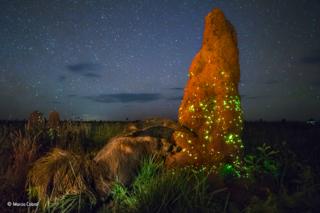Wildlife Photo Competition Disqualifies 'stuffed Anteater' Image

 Image copyright
Marcio Cabral
Image copyright
Marcio Cabral
A winning entry in the Wildlife Photographer of the Year competition has been disqualified for featuring a taxidermy specimen.
The image, known as The Night Raider, shows an anteater moving towards a termite mound in a Brazilian reserve.
London's Natural History Museum, which runs the competition, says the use of stuffed animals breaches its rules.
The photographer, Marcio Cabral, denies he faked the scene and claims there is a witness who was with him on the day.
Other photographers and tourists were in the park at the same time and therefore "it would be very unlikely anyone wouldn't see a stuffed animal being transported and placed carefully in this position", he told BBC News.
But Roz Kidman Cox, the chair of judges for Wildlife Photographer of the Year (WPY), was stern in her criticism.
"This disqualification should remind entrants that any transgression of the rules and spirit of the competition will eventually be found out," she said.
The Night Raider picture won the Animals In Their Environment category in the 2017 WPY awards. It was taken in Emas National Park.
The green lights are click beetles hoping to lure termites into being their prey with a bioluminescent display.
The anteater's appearance was described in the citation caption as being serendipitous - a "surprise bonus" that walked into the shot. But the Natural History Museum (NHM) says third parties recently raised concerns the image was staged - that the hungry interloper is in fact a static model that can be seen at a visitors' centre at an entrance to the reserve.
When alerted to this possibility, the museum asked five scientists to review the winning photo and to compare it with the centre's display model.
These experts, who included the NHM's own taxidermy specialist and South American mammal and anteater researchers, worked independently of each other, but they all came to the same conclusion - that the two animals were one and the same.
The scientists found the markings, the postures, the morphologies and even the positioning of the fur tufts to be just too similar.
Nature's reality
The NHM says Mr Cabral fully cooperated with the investigation, supplying RAW images for inspection that were taken "before" and "after" the winning scene. But none of these included the anteater.
"Unfortunately, I do not have another image of the animal because it is a long exposure of 30 seconds and ISO 5000," Mr Cabral said.
"After the flashes were fired, the animal left the place, so it was not possible to make another photo with the animal coming out of the place that is totally dark."
The WPY rules state that "entries must not deceive the viewer or attempt to misrepresent the reality of nature". And it is on this basis that The Night Raider has been stripped of its title and removed from display in the competition's UK tour.
Roz Kidman Cox has been a judge on WPY for more than 30 years. She told the BBC: "I find it disheartening and surprising that a photographer would go to such lengths to deceive the competition and its worldwide following.
"The competition places great store on honesty and integrity, and such a breach of the rules is disrespectful to the wildlife-photography community, which is at the heart of the competition."
Iberian wolf
This is not the first time the WPY judges have had to disqualify a winning entry. In 2009, they threw out the grand prize photo that supposedly depicted a wild Spanish wolf jumping over a gate.
A similar investigation concluded that the pictured animal was not wild at all, but a tame wolf from a zoo.
Ms Kidman Cox said the judges were always alert to the possibility that photos might be staged but that the artifice could be very hard to spot if the featured animals were in a natural pose in a low-lit scene.
"The judges themselves are chosen to include a range of skills and expertise, both biological and photographic, and are well able to question the veracity of an image," she added.
"The rules also make it clear that the competition champions honest and ethical photography, and they are translated into a number of languages to prevent any misunderstanding."
Mr Cabral describes his exclusion as a sad decision and one he will continue to contest.
The visitors' centre is locked at night and has guards and so he could not have had access to the model, the photographer says. He intends to return to Emas National Park later this year to collect evidence that he believes will exonerate him.
Jonathan.Amos-INTERNET@bbc.co.uk and follow me on Twitter: @BBCAmos
From Chip War To Cloud War: The Next Frontier In Global Tech Competition
The global chip war, characterized by intense competition among nations and corporations for supremacy in semiconductor ... Read more
The High Stakes Of Tech Regulation: Security Risks And Market Dynamics
The influence of tech giants in the global economy continues to grow, raising crucial questions about how to balance sec... Read more
The Tyranny Of Instagram Interiors: Why It's Time To Break Free From Algorithm-Driven Aesthetics
Instagram has become a dominant force in shaping interior design trends, offering a seemingly endless stream of inspirat... Read more
The Data Crunch In AI: Strategies For Sustainability
Exploring solutions to the imminent exhaustion of internet data for AI training.As the artificial intelligence (AI) indu... Read more
Google Abandons Four-Year Effort To Remove Cookies From Chrome Browser
After four years of dedicated effort, Google has decided to abandon its plan to remove third-party cookies from its Chro... Read more
LinkedIn Embraces AI And Gamification To Drive User Engagement And Revenue
In an effort to tackle slowing revenue growth and enhance user engagement, LinkedIn is turning to artificial intelligenc... Read more

